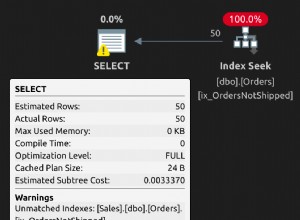returns setof refcursor significa que você obtém um ResultSet normal onde cada "linha" contém outra ResultSet ao chamar getObject() :O seguinte funciona para mim:
ResultSet rs = stmt.executeQuery("select * from usp_sel_article_initialdata_new1()");
if (rs.next())
{
// first result set returned
Object o = rs.getObject(1);
if (o instanceof ResultSet)
{
ResultSet rs1 = (ResultSet)o;
while (rs1.next())
{
int id = rs1.getInt(1);
String name = rs1.getString(2);
.... retrieve the other columns using the approriate getXXX() calls
}
}
}
if (rs.next())
{
// process second ResultSet
Object o = rs.getObject(1);
if (o instanceof ResultSet)
{
ResultSet rs2 = (ResultSet)o;
while (rs2.next())
{
......
}
}
}
De dentro do
psql você também pode usar select * from usp_sel_article_initialdata_new1() você só precisa usar FETCH ALL mais tarde. Consulte o manual para obter um exemplo:http://www. postgresql.org/docs/current/static/plpgsql-cursors.html#AEN59018
postgres=> select * from usp_sel_article_initialdata_new1();
usp_sel_article_initialdata_new1
----------------------------------
<unnamed portal 1>
<unnamed portal 2>
(2 rows)
postgres=> fetch all from "<unnamed portal 1>";
?column?
----------
1
(1 row)
postgres=> fetch all from "<unnamed portal 2>";
?column?
----------
2
(1 row)
postgres=>
(Criei uma função fictícia para o exemplo acima que retorna apenas uma única linha com o valor
1 para o primeiro cursor e 2 para o segundo cursor) Editar :
Para que isso funcione, isso precisa ser executado dentro de uma transação. Portanto, o autocommit deve ser desativado:
connection.setAutoCommit(false);




